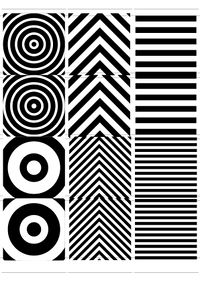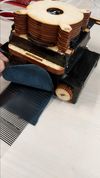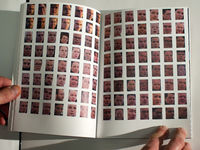Andreas methods 10-04-19: Difference between revisions
| Line 65: | Line 65: | ||
BARTHES, Roland, 1978: »Rhetorik des Bildes« [1964 a], in: G. Schiwy (Hg.): Der französische Strukturalismus. Mode, Methode, Ideologie, Reinbek bei Hamburg, S. 158–166 | |||
FRIEDRICH, Thomas u. SCHWEPPENHÄUSER, Gerhard, 2010. Bildsemiotik – Grundlagen und exemplarische Analysen visueller Kommunikation, – Basel, Boston, Berlin. | |||
HÄRTER, Andreas. 2000. Digressionen : Studien zum Verhältnis von Ordnung und Abweichung in Rhetorik und Poetik; Quintilian - Opitz - Gottsched - Friedrich Schlegel - München : Fink. | |||
HOFMANN, Norbert. 1980. Redundanz und Äquivalenz in der literarischen Übersetzung : dargestellt an fünf deutschen Übersetzungen des Hamlet. – Tübingen : Niemeyer. | |||
JÄGER, Dr. Maren 2007. Brevitas: Kürze in Rhetorik und Poetik MNDL/EUL-3: – 2011, Johannes Gutenberg-Universität Mainz. | |||
NÜSSLEIN, Theodor. 2014. Rhetorica ad Herennium : lateinisch-deutsch [E-Book] herausgegeben und übersetzt von Theodor Nüßlein. – 2. Auflage. – Berlin : De Gruyter | |||
PAPE, Wilhelm. 1914 (bearbeitet von Max Sengebusch) Handwörterbuch der griechischen Sprache. Griechisch-deutsches Handwörterbuch. Band 1: A-K, Band 2: Δ–Ω. 3. Auflage, 6. Abdruck, Vieweg & Sohn, Braunschweig. | |||
ROSA, Hartmut. 2016 Beschleunigung und Entfremdung: Entwurf einer kritischen Theorie spätmoderner Zeitlichkeit – 5. Auflage. – Berlin : Suhrkamp, | |||
STREHLE, S. 2012. Zeichenökonomie und symbolischer Tausch. In: Zur Aktualität von Jean Baudrillard, | |||
VS Verlag für Sozialwissenschaften. | |||
Revision as of 12:19, 10 April 2019
Word count 1500 max.
What have you been making?
In my work I want to explore „brevitas“ in the moving image and bring into a series of semiotics. From ancient times to the modern era the rhetoric has been the binding and constant guideline of communication. Nowadays there is less new in the rhetoric, even though the complexity of content has increased. Also, there seems to be a dominance of the visual in the „screen-“ or „display culture“. The term of „brevitas“ has been explored extensively in verbal/written communication. Also in product design, architecture (baroque vs minimalist design) or visual communication there has been big research on the topic of reduction vs excess.
How did you do it? (method)
Before heading over to the moving image I wanted to get the basics straight and therefore started out with various smaller experiments that related to photography:
1) Maximise – Minimize
Building my own camera within the focal camera workshop enabled me to create images similar to the lenticular method. What would happen if I bring in two subjects into one image? Since I already explored double exposures before my studies I wanted to try this out with a shaped mask behind the photo paper.
I lasercut a stripe-shaped mask that would be placed in front of the Negative. This shape would be movable between to positions. After exposing the first half I would move the striped shape to the second position and expose the missing parts of the negative.
2) Reduction through cropping an image
Together with Susanna Fasciolo I made a photo series called “Frown”, depicting portraits of cyclists and people who ride their scooters over the Erasmusbridge. The book consists of cropped images showing faces. At first, the actual topic is not being revealed. You can only see the cropped faces in a grid of 7 x 8 photos per page. Every page consists of two pages (similar to the japanese binding) that are folded, perforated and can – ultimately – be opened on the perforation. The reader is forced to make assumptions on where these photos could have been taken. Have all these people been in one big crowd? Are they at a demonstration? Only by opening the perforation on each page one can find out more about the scene.
3) Reducing the set
For my film for the eye I set myself a few parameters:
- Reduction to a single room/hallway.
- Reducing the colours to black and white.
Therefore the actress had to convey much more emotion through her mimics and gestures.
„How is the image becoming its sense?“ Roland Barthes is asking in his essay „Rhetorik des Bildes“. And further: „Where does this sense end? And if it ends, what is beyond this end?“ (Barthes 1964, p. 159). Basis of this structural analyses is the thought, that even non-spoken information is inheriting speech-analogue structures. That means that pictures can be statements. That is when they have their own rhetoric and it is even more the case for combination of picture and text. Barthes discovers in, „nature“ and „history“ always being confused with each other, a „ideological misuse“ (ebd. p. 7). Who wants to get to the bottom of these things, has to understand that in our culture and our society nothing has to be as it is right now. Everything could also be different. And in many respects it is desirable for it to being different. The production of visual mythologies can prevent from thinking about that. If the world is, as it is, and will stay like that forever; if the signs are assigned to the things by nature, then it is not necessary to think critically about the order of things and signs.
On the other hand it is the task of communication designers to contain the fundamental ambiguity of isolated text or imagery to a specific purpose. This is a specific form of communicative rationality, a visual economy, that – because of it being created for that purpose – is radically varying from the practice arts. According to Thomas Friedrich, this containment of ambiguity does not necessarily have to lead to unambiguousness. Communication can be designed the way, that it can be read in various styles. This ambiguity should not be dysfunctional in terms of communicative purpose. One would have to differentiate functional from dysfunctional ambiguity. Only the last should be avoided – and the communicative practice is showing, that it is not always easy, because unintentional connotations can occur.
Relation to previous practice
Identify developing practices and theoretical approaches over the last year. This can be very practical: new working methods, new skills &c; describe what such new skills afford.
What do you want to make next?
How does your proposed future research connect to previous projects you have done? Here you can use the descriptions you made during the Methods seminar or make new descriptions.
Why do you want to make it?
This exercise is trying to find the „modest“ or „appropriate“ amount of communication. It shall remove decoration, accessories and digression or even add all these redundancies to find the essence. How is simplification or excess changing the visual appearance of content? From which point of the reduction or maximisation of content is distorting the content itself? On the example of translators – like for every other communication that is involving a third party – there is a risk, that para- and nonverbal signs may be terminated or corrupted. In which extent are there changes in the visual communication, that may have great impact on the reception?
Relation to a larger context
Meaning practices or ideas that go beyond the scope of your personal work. Write briefly about other projects or theoretical material which share an affinity with your work. At this juncture, it's simply about showing an awareness of a broader context, which you will later build upon as your research progresses.
References
BARTHES, Roland, 1978: »Rhetorik des Bildes« [1964 a], in: G. Schiwy (Hg.): Der französische Strukturalismus. Mode, Methode, Ideologie, Reinbek bei Hamburg, S. 158–166
FRIEDRICH, Thomas u. SCHWEPPENHÄUSER, Gerhard, 2010. Bildsemiotik – Grundlagen und exemplarische Analysen visueller Kommunikation, – Basel, Boston, Berlin.
HÄRTER, Andreas. 2000. Digressionen : Studien zum Verhältnis von Ordnung und Abweichung in Rhetorik und Poetik; Quintilian - Opitz - Gottsched - Friedrich Schlegel - München : Fink.
HOFMANN, Norbert. 1980. Redundanz und Äquivalenz in der literarischen Übersetzung : dargestellt an fünf deutschen Übersetzungen des Hamlet. – Tübingen : Niemeyer.
JÄGER, Dr. Maren 2007. Brevitas: Kürze in Rhetorik und Poetik MNDL/EUL-3: – 2011, Johannes Gutenberg-Universität Mainz.
NÜSSLEIN, Theodor. 2014. Rhetorica ad Herennium : lateinisch-deutsch [E-Book] herausgegeben und übersetzt von Theodor Nüßlein. – 2. Auflage. – Berlin : De Gruyter
PAPE, Wilhelm. 1914 (bearbeitet von Max Sengebusch) Handwörterbuch der griechischen Sprache. Griechisch-deutsches Handwörterbuch. Band 1: A-K, Band 2: Δ–Ω. 3. Auflage, 6. Abdruck, Vieweg & Sohn, Braunschweig.
ROSA, Hartmut. 2016 Beschleunigung und Entfremdung: Entwurf einer kritischen Theorie spätmoderner Zeitlichkeit – 5. Auflage. – Berlin : Suhrkamp,
STREHLE, S. 2012. Zeichenökonomie und symbolischer Tausch. In: Zur Aktualität von Jean Baudrillard, VS Verlag für Sozialwissenschaften.
Back to RW&RM Seminar:





